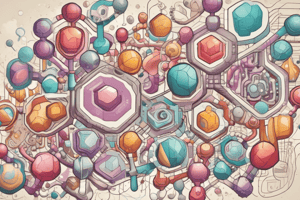Podcast
Questions and Answers
What are the main sources of the body's amino acid pool?
What are the main sources of the body's amino acid pool?
- Dietary protein, protein turnover, and biosynthesis in the liver (correct)
- Glycogen, starch, and cellulose
- Triglycerides, bile salts, and cholesterol
- Stored fats, glucose, and vitamins
What happens to amino acids during prolonged fasting?
What happens to amino acids during prolonged fasting?
- They are converted to glucose (correct)
- They are converted to glycogen
- They are stored in the liver
- They are excreted in urine
Which amino acids are considered glucogenic?
Which amino acids are considered glucogenic?
- Those degraded to acetyl CoA
- Those synthesized in the liver
- Those degraded to pyruvate or citric acid cycle intermediates (correct)
- Those that contain sulfur
What is the primary function of the urea cycle?
What is the primary function of the urea cycle?
What enzyme is involved in the formation of urea from ammonia?
What enzyme is involved in the formation of urea from ammonia?
Which amino acids are purely ketogenic?
Which amino acids are purely ketogenic?
Which process primarily generates ammonia in the body?
Which process primarily generates ammonia in the body?
Which of the following is a key intermediate in the urea cycle?
Which of the following is a key intermediate in the urea cycle?
What is the main energy reserve in the human body?
What is the main energy reserve in the human body?
Which process produces acetyl CoA, FADH2, and NADH?
Which process produces acetyl CoA, FADH2, and NADH?
Which process does not require ATP?
Which process does not require ATP?
What shuttle system transports acetyl CoA to the cytosol for lipogenesis?
What shuttle system transports acetyl CoA to the cytosol for lipogenesis?
What is the reducing agent required for lipogenesis?
What is the reducing agent required for lipogenesis?
Where does fatty acid activation occur?
Where does fatty acid activation occur?
What is the fate of excess acetyl CoA when dietary intake exceeds energy needs?
What is the fate of excess acetyl CoA when dietary intake exceeds energy needs?
Which function do bile salts primarily serve?
Which function do bile salts primarily serve?
Flashcards are hidden until you start studying
Study Notes
Amino Acids and Their Metabolism
- The body's amino acid pool is derived from dietary protein, protein turnover, and hepatic biosynthesis.
- During prolonged fasting, amino acids are converted to glucose to provide energy.
- Glucogenic amino acids are those that can be degraded to pyruvate or citric acid cycle intermediates.
Urea Cycle Functionality
- The primary role of the urea cycle is to eliminate ammonia from the body, a toxic byproduct of amino acid catabolism.
- Carbamoyl phosphate synthetase is the enzyme responsible for converting ammonia into urea.
Ketogenic and Glucogenic Amino Acids
- Leucine and lysine are classified as purely ketogenic amino acids, as they are converted into ketone bodies.
- Fumarate, produced in the urea cycle, enters the citric acid cycle, playing a critical role in cellular energy production.
Digestive Processes
- Bile salts function to emulsify fats, aiding in their digestion and absorption.
- Triacylglycerol (fat reserves) serves as the main energy reserve in the human body, surpassing other forms like glycogen and protein.
Energy Production Pathways
- Beta-oxidation of fatty acids generates acetyl CoA, FADH2, and NADH, which enter metabolic pathways for energy production.
- Fatty acid activation occurs at the outer mitochondrial membrane, preparing the fatty acids for further metabolism.
Lipogenesis and Transport Mechanisms
- The citrate-malate shuttle system transports acetyl CoA into the cytosol for lipogenesis, facilitating fat synthesis.
- NADPH acts as the crucial reducing agent in lipogenesis, necessary for synthesizing fatty acids.
Metabolic Pathway Characteristics
- When dietary intake exceeds energy requirements, excess acetyl CoA is redirected for fatty acid biosynthesis, promoting fat storage.
- Beta-oxidation does not require ATP, contrasting with processes like fatty acid activation and protein synthesis, which do involve ATP consumption.
Fatty Acid Metabolism
- The products of beta-oxidation include acetyl CoA, FADH2, and NADH, which are vital for energy production in the cell.
Studying That Suits You
Use AI to generate personalized quizzes and flashcards to suit your learning preferences.




